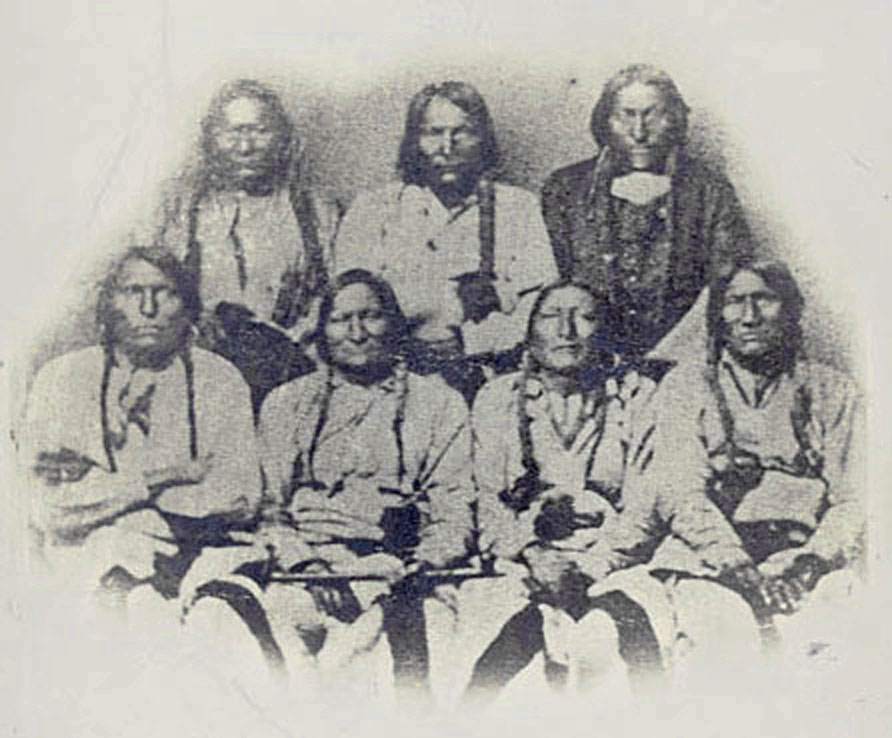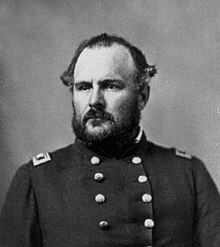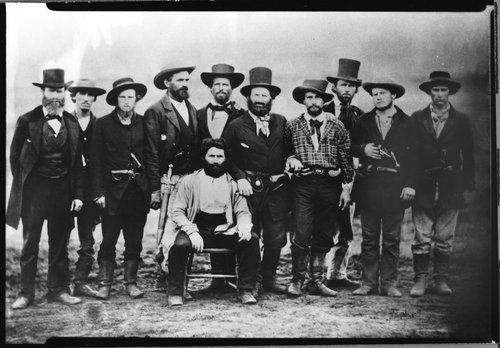In 1851, the Treaty of Fort Laramie recognized that the Cheyenne and Arapaho held territory encompassing land between the North Platte River and Arkansas River from the Rocky Mountains to western Kansas. By 1859, gold was discovered in the Rockies bringing a gold rush to what was then western Kansas Territory. The Cheyenne and Arapaho urged federal authorities to redefine what their lands were and in the fall of 1860, a new treaty was negotiated.
 |
The delegation of Kiowa, Cheyenne and
Arapaho chiefs, September 1864. Black
Kettle is 2nd from left, front row.
Photo: Smithsonian Institute. |
The Treaty of Fort Wise was signed February of 1861. The new reserve was less than 1/13th the size of the 1851 reserve. Some bands were angry at the chiefs who signed the treaty feeling that the treaty was signed by a minority and didn't fully represent the rest of the tribe and refused to abide by the treaty. Black Kettle, leading chief of a band of around 800 mostly Southern Cheyenne, led his band to Fort Lyon in accordance with provisions of a peace parley held in Denver in September 1864. Bands not abiding by the 1861 treaty were not a part of Black Kettle's tribe nor a part of the Arapaho who joined Black Kettle in November. Black Kettle flew an American flag and a white flag as ordered by the commander of nearby Fort Lyon suggested to show he was friendly and was assured of protection.
 |
| Col. John Chivington |
Meanwhile, Colonel John Chivington and his 700 soldiers went to Fort Lyon and then set out for Black Kettle's camp. The evening of November 28, 1964, the soldiers and militia drank heavily and celebrated their anticipated victory. Disregarding the American and white flag, Chivington and his men attacked. Numbers vary about how many Indians were killed ranging from as high as 600 to 20. Chivington and his men scalped many of the dead including the women and children and dressed their weapons, hats and other gear with scalps, human fetuses and genitalia.
 |
Silas Soule, circa 1864-65.
Photo: Denver Public Library |
Silas Soule was born in 1838 in Bath, Maine and, in 1854, joined his family with the New England Emigrant Aid Company in settling the Kansas Territory. The Soule family was one of founding families of Lawrence. Silas' mother and two sisters arrived in Kansas the following summer and the Soules moved to the Coal Creek area of Douglas County near present day Vinland. The Soule house was a stop on the Underground Railroad and Silas, at the age of 17, was helping escort slaves who had escaped from Missouri.
In July 1859, 20 pro-slavery men crossed into Kansas and ambushed a party led by Dr. John Doy who was escorting 13 former slaves to Iowa. The men from Missouri arrested Doy, tried and convicted him sentencing him to five years in prison. Soule and a group of other men decided to free Doy, overpowered the jailer, freeing Doy and leading him across the border back to Kansas. When they got back to Lawrence, their photo was taken. The photo, called The Immortal Ten, is widely circulated and a Kansas icon. Soule was also tasked with freeing John Brown after he was captured after his raid on Harper's Ferry. Brown allowed himself to be hanged hoping his death would start a war. Soule then tried to free two of Brown's men who refused to come with him.
 |
The John Doy rescue party "The Immortal Ten." Doy is seated. Soule is 2nd
from the right. Photo: Amon Gilbert DeLee, courtesy Kansas State Historical Society. |
During the Colorado gold rush in 1860, Soule, along with his brother and cousin, went out west where he dug for gold and worked in a blacksmith shop. In 1861, after the start of the Civil War, Soule enlisted in Company K, 1st Colorado Infantry and took part in the victorious New Mexico Campaign of 1862. In November 1864, he was assigned the command of Company D. On November 29, Soule and his men were with Colonel Chivington at Sand Creek when he ordered the cavalry to attack the Cheyenne and Arapaho camp. Seeing that the camp was flying an American and white flag, Soule, and Lt. Joseph Cramer, ordered their men to hold their fire.
The Army investigated what would become the Sand Creek Massacre and Soule testified against Chivington in court in January 1865. Soule was married to Hersa Coberly in March of 1865 and was on duty as a Provost Marshal in Denver on April 23, 1865 when shots rang out. One of the bullets hit Soule in the head, killing him almost instantly. It is believed that someone who was a supporter of Chivington did the killing or ordered it. The murderer was never brought to justice. Soule was buried in Denver's historic Riverside Cemetery and is remembered every year during remembrance ceremonies of the Sand Creek Massacre where the graves of Soule and Cramer are decorated. A plaque commemorating Soule was also placed on a building at 15th and Arapaho in Denver.
 |
Soule's gravestone in Riverside Cemetery
in Denver, Colorado. Courtesy FindAGrave. |





